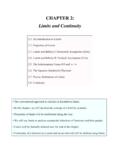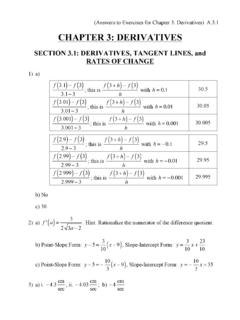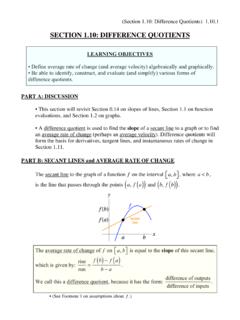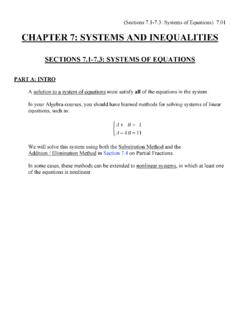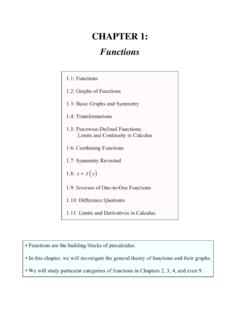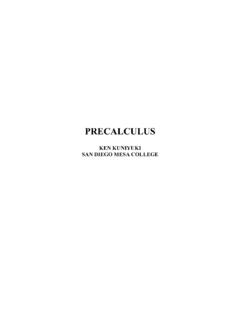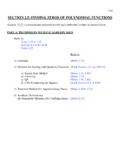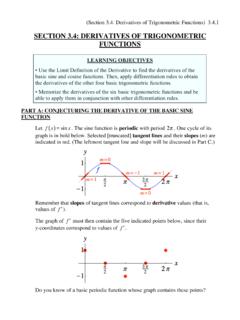Transcription of www.kkuniyuk.com
1 (Section : The Squeeze (Sandwich) Theorem) SECTION : THE SQUEEZE (SANDWICH) THEOREM LEARNING OBJECTIVES Understand and be able to rigorously apply the Squeeze (Sandwich) Theorem when evaluating limits at a point and long-run limits at ()infinity. PART A: APPLYING THE SQUEEZE (SANDWICH) THEOREM TO LIMITS AT A POINT We will formally state the Squeeze (Sandwich) Theorem in Part B. Example 1 below is one of many basic examples where we use the Squeeze (Sandwich) Theorem to show that limx 0fx()=0, where fx() is the product of a sine or cosine expression and a monomial of even degree. The idea is that something approaching 0 times something bounded (that is, trapped between two real numbers) will approach 0.
2 Informally, Limit Form 0 bounded() 0. Example 1 (Applying the Squeeze (Sandwich) Theorem to a Limit at a Point) Let fx()=x2cos1x . Prove that limx 0fx()=0. Solution We first bound cos1x , which is real for all x 0. Multiply all three parts by x2 so that the middle part becomes fx(). WARNING 1: We must observe that x2>0 for all x 0, or at least on a punctured neighborhood of x=0, so that we can multiply by x2 without reversing inequality symbols. 1 cos1x 1 x 0() x2 x2cos1x x2 x 0() (Section : The Squeeze (Sandwich) Theorem) As x 0, the left and right parts approach 0. Therefore, by the Squeeze (Sandwich) Theorem, the middle part, fx(), is forced to approach 0, also.
3 The middle part is squeezed or sandwiched between the left and right parts, so it must approach the same limit as the other two do. limx 0 x2()=0, and limx 0x2=0, so limx 0x2cos1x =0 by the Squeeze Theorem. Shorthand: As x 0, x2 0 x2cos1x Therefore, 0by the Squeeze(Sandwich) Theorem x2 0 x 0(). The graph of y=x2cos1x , together with the squeezing graphs of y= x2 and y=x2, is below. (The axes are scaled differently.) (Section : The Squeeze (Sandwich) Theorem) Example 2 below, fx() is the product of a sine or cosine expression and a monomial of odd degree. Example 2 (Handling Complications with Signs) Let fx()=x3sin1x3 . Use the Squeeze Theorem to find limx 0fx().
4 Solution 1 (Using Absolute Value) We first bound sin1x3 , which is real for all x 0. WARNING 2: The problem with multiplying all three parts by x3 is that x3<0 when x<0. The inequality symbols would have to be reversed for x<0. Instead, we use absolute value here. We could write 0 sin1x3 1 x 0(), but we assume that absolute values are nonnegative. Multiply both sides of the inequality by x3. We know x3>0 x 0(). The product of absolute values equals the absolute value of the product. If, say, a 4, then 4 a 4. Similarly: 1 sin1x3 1 x 0() sin1x3 1 x 0() x3sin1x3 x3 x 0() x3sin1x3 x3 x 0() x3 x3sin1x3 x3 x 0() (Section : The Squeeze (Sandwich) Theorem) Now, apply the Squeeze (Sandwich) Theorem.
5 Limx 0 x3()=0, and limx 0x3=0, so limx 0x3sin1x3 =0 by the Squeeze Theorem. Shorthand: As x 0, x3 0 x3sin1x3 Therefore, 0by the Squeeze(Sandwich) Theorem x3 0 x 0(). Solution 2 (Split Into Cases: Analyze Right-Hand and Left-Hand Limits Separately) First, we analyze: limx 0+x3sin1x3 . Assume x>0, since we are taking a limit as x 0+. We first bound sin1x3 , which is real for all x 0. Multiply all three parts by x3 so that the middle part becomes fx(). We know x3>0 for all x>0. Now, apply the Squeeze (Sandwich) Theorem. 1 sin1x3 1 x>0() x3 x3sin1x3 x3 x>0() limx 0+ x3()=0, and limx 0+x3=0, so limx 0+x3sin1x3 =0 by the Squeeze Theorem.
6 Shorthand: As x 0+, x3 0 x3sin1x3 Therefore, 0by the Squeeze(Sandwich) Theorem x3 0 x>0().(Section : The Squeeze (Sandwich) Theorem) Second, we analyze: limx 0 x3sin1x3 . Assume x<0, since we are taking a limit as x 0 . We first bound sin1x3 , which is real for all x 0. Multiply all three parts by x3 so that the middle part becomes fx(). We know x3<0 for all x<0, so we reverse the inequality symbols. Reversing the compound inequality will make it easier to read. Now, apply the Squeeze (Sandwich) Theorem. 1 sin1x3 1 x<0() x3 x3sin1x3 x3 x<0() x3 x3sin1x3 x3 x<0() limx 0 x3=0, and limx 0 x3()=0, so limx 0 x3sin1x3 =0 by the Squeeze Theorem.
7 Shorthand: As x 0 , x3 0 x3sin1x3 Therefore, 0by the Squeeze(Sandwich) Theorem x3 0 x<0(). Now, limx 0+x3sin1x3 =0, and limx 0 x3sin1x3 =0, so limx 0x3sin1x3 =0. (Section : The Squeeze (Sandwich) Theorem) Example 3 (Limits are Local) Use limx 0x2=0 and limx 0x6=0 to show that limx 0x4=0. Solution Let I= 1, 1()\0{}. I is a punctured neighborhood of 0. Shorthand: As x 0, x6 0 x4 Therefore, 0by the Squeeze(Sandwich) Theorem x2 0 x I() WARNING 3: The direction of the inequality symbols may confuse students. Observe that 12 4=116, 12 2=14, and 116<14. We conclude: limx 0x4=0. We do not need the compound inequality to hold true for all nonzero values of x.
8 We only need it to hold true on some punctured neighborhood of 0 so that we may apply the Squeeze (Sandwich) Theorem to the two-sided limit limx 0x4. This is because Limits are Local. As seen below, the graphs of y=x6 and y=x2 squeeze (from below and above, respectively) the graph of y=x4 on I. In Chapter 6, we will be able to find the areas of the bounded regions. (Section : The Squeeze (Sandwich) Theorem) PART B: THE SQUEEZE (SANDWICH) THEOREM We will call B the bottom function and T the top function. The Squeeze (Sandwich) Theorem Let B and T be functions such that Bx() fx() Tx() on a punctured neighborhood of a. If limx aBx()=L and limx aTx()=LL (), then limx afx()=L.
9 Variation for Right-Hand Limits at a Point Let Bx() fx() Tx() on some right-neighborhood of a. If limx a+Bx()=L and limx a+Tx()=LL (), then limx a+fx()=L. Variation for Left-Hand Limits at a Point Let Bx() fx() Tx() on some left-neighborhood of a. \ If limx a Bx()=L and limx a Tx()=LL (), then limx a fx()=L. PART C: VARIATIONS FOR LONG-RUN LIMITS In the upcoming Example 4, fx() is the quotient of a sine or cosine expression and a polynomial. The idea is that something bounded divided by something approaching ()infinity will approach 0. Informally, Limit Form bounded 0. (Section : The Squeeze (Sandwich) Theorem) Example 4 (Applying the Squeeze (Sandwich) Theorem to a Long-Run Limit; Revisiting Section , Example 6) Evaluate: a) limx fx() and b) limx fx(), where fx()=sinxx.
10 Solution to a) Assume x>0, since we are taking a limit as x . We first bound sinx. Divide all three parts by x x>0() so that the middle part becomes fx(). 1 sinx 1 x>0() 1x sinxx 1x x>0() Now, apply the Squeeze (Sandwich) Theorem. limx 1x =0, and limx 1x=0, so limx sinxx=0 by the Squeeze Theorem. Shorthand: As x , 1x 0 sinxxTherefore, 0by the Squeeze(Sandwich) Theorem 1x 0 x>0(). Solution to b) Assume x<0, since we are taking a limit as x . We first bound sinx. Divide all three parts by x so that the middle part becomes fx(). But x<0, so we must reverse the inequality symbols. Reversing the compound inequality will make it easier to read.
